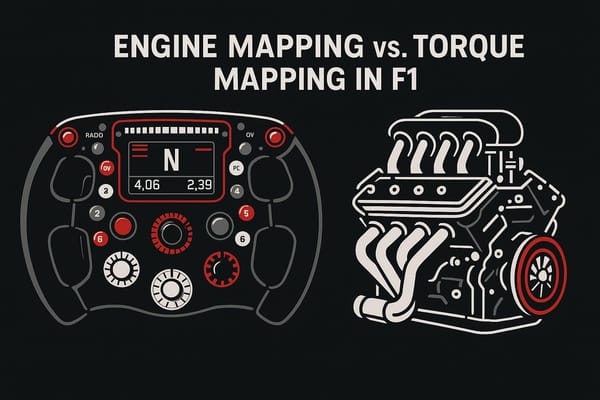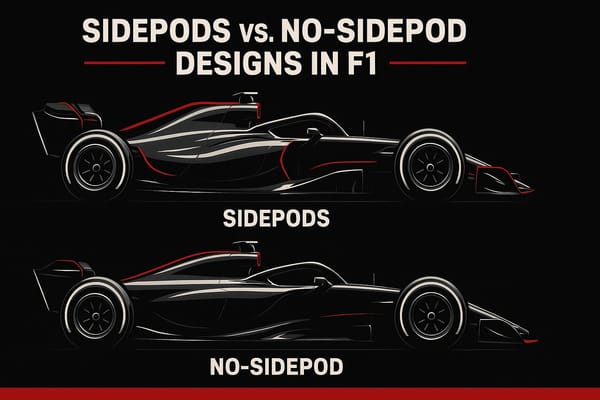2026 F1 Power Units: ERS Tech Breakdown
Explore the groundbreaking changes in Formula 1's 2026 power units, focusing on enhanced electric power and sustainability efforts.

Formula 1 is transforming in 2026 with massive changes to its power units. Here's what you need to know:
- Electric power triples: ERS output jumps from 120 kW (2024) to 350 kW (2026) - a 292% increase.
- ICE power drops: Internal combustion engine output reduces from 550-560 kW to 400 kW (-27%).
- Power balance shifts: The ICE-to-electric ratio moves from 80/20 (2024) to 53/47 (2026).
- MGU-H removed: Teams will focus entirely on the MGU-K for energy recovery and deployment.
- Sustainability focus: Power units will use fully sustainable fuels.
- Aerodynamic changes: Drag reduces by 55%, and downforce drops by 30%.
| 2024 vs. 2026 Power Units | 2024 | 2026 | Change |
|---|---|---|---|
| ICE Output | 550–560 kW | 400 kW | -27% |
| ERS Output | 120 kW | 350 kW | +292% |
| Power Split | 80/20 | 53/47 | Shift to electric |
These changes aim to balance high performance with sustainability while introducing new challenges for teams. Expect faster acceleration, extended energy deployment, and new race strategies as F1 evolves.
The 2026 Engine Changes Explained! | F1 TV Tech Talk | Crypto.com

Current 2024 ERS Design
The 2024 Formula 1 Energy Recovery System (ERS) is built around two key components: the MGU-K and the MGU-H. The MGU-K (Motor Generator Unit - Kinetic) is connected to the engine's crankshaft and captures kinetic energy during braking. Meanwhile, the MGU-H (Motor Generator Unit - Heat) works with the turbocharger, recovering energy from exhaust gases and helping to reduce turbo lag.
The system's performance is tightly regulated, with specific power outputs and energy limits:
| Component | Power Output | Energy Limits |
|---|---|---|
| MGU-K | 120 kW | 2 MJ recovery per lap* |
| MGU-H | Variable | Unlimited energy recovery |
| Total System | 120 kW (~160 hp) | 4 MJ deployment per lap |
*Deployment allows roughly 33 seconds of full power per lap.
At the core of this system is a lithium-ion Energy Store (ES), weighing about 20–25 kg (44–55 lbs). This battery is specifically designed for the rapid charge and discharge cycles demanded by Formula 1 racing. Control electronics manage the flow of energy between the MGU-K, MGU-H, and the Energy Store, ensuring efficient operation.
The MGU-K generates electricity by converting the heat produced during braking into usable energy, while the MGU-H captures energy from exhaust gases. Together, these units maximize energy recovery and deployment.
Thermal management is a critical challenge with the ERS. Teams use advanced cooling systems and heat exchangers that not only maintain the system's performance but also factor in aerodynamic efficiency. Energy deployment strategies are tailored to individual tracks and race conditions, with algorithms allowing drivers to adjust energy modes through steering wheel controls. This makes energy management a pivotal part of both qualifying sessions and race-day tactics.
The 2024 ERS sets a high standard, providing the foundation for the anticipated updates in 2026.
New 2026 ERS Specifications
The 2026 regulations bring a major overhaul to the Energy Recovery System (ERS), shifting its role to work exclusively alongside the internal combustion engine (ICE). A key highlight is the enhanced MGU-K, now capable of delivering 350 kW, which is nearly three times its current capacity.
The ERS system is built around three core components:
| Component | Function | Specification |
|---|---|---|
| MGU-K | Recovers and deploys energy | 350 kW max output |
| CU-K | Manages power distribution | Energy distribution |
| Phase Cables | Transmits high-voltage power | High-voltage capable |
These upgrades set the stage for a new balance in power delivery. Here's a breakdown of how the power dynamics will change:
| Power Source | Current (2024) | New (2026) | Change |
|---|---|---|---|
| ICE Output | 550–560 kW | 400 kW | –27% |
| ERS Output | 120 kW | 350 kW | +~300% |
This reconfiguration directly addresses the limitations of the 2024 ERS, making energy recovery and deployment much more efficient.
To ensure compliance and performance, the FIA has introduced strict testing protocols for ERS development. These include monitored bench tests and single-cylinder dynamometer evaluations. Additionally, the upgraded battery management system is designed to handle increased electrical loads, using advanced strategies to optimize energy harvesting and deployment during races.
"The only Power Unit that may be used at a Competition during the 2026-2030 Championship seasons is a Power Unit which is constituted only of elements that were in conformity, at the date they were introduced in the race pool, with the latest submitted and approved homologation dossier."
Drivers will be limited to just three complete power units per championship season, emphasizing the importance of reliability. Furthermore, the 2026 power units align with Formula 1's push for sustainability, as they will run exclusively on sustainable fuel.
Performance Analysis
The updated performance metrics bring noticeable changes to acceleration, energy deployment, and recovery efficiency on the track:
| Performance Metric | 2024 System | 2026 System | Impact on Racing |
|---|---|---|---|
| Peak Electric Power | 120 kW | 350 kW | Faster acceleration and better overtaking |
| Power Deployment Duration | Limited | Extended | Allows for more strategic energy use |
| Energy Recovery Efficiency | Standard | Enhanced | Ensures more consistent power availability |
With the 2026 system delivering 350 kW of peak electric power, it compensates for a 27% reduction in internal combustion engine (ICE) output. This shift reshapes energy management strategies during races, offering teams new opportunities to optimize performance under evolving conditions.
Aerodynamic upgrades - previously discussed - work hand-in-hand with these power enhancements. By reducing drag by 55% and downforce by 30%, energy consumption at higher speeds is significantly reduced, creating a more efficient racing setup.
However, the increased power output brings higher current demands, requiring a complete redesign of the battery management system to prioritize both safety and efficiency. Regulations mandate that all power unit components used during the 2026–2030 seasons must align with the latest homologation standards.
Another major change is the removal of the MGU-H, redirecting engineering focus entirely to the MGU-K. This streamlined design simplifies the system but introduces new challenges, as teams must concentrate on optimizing the remaining components. This focus could lead to improved system reliability over time.
The new energy recovery system (ERS) configuration offers a platform that balances high performance with environmental responsibility. Teams now face the critical task of leveraging the increased electric power while carefully managing battery charge levels to maintain competitive lap times. This dual challenge will likely define much of the strategic and technical adjustments in the coming seasons.
Conclusion
The shift from 2024 to 2026 ERS systems marks a major turning point in Formula 1. With electric power output jumping from 120 kW to 350 kW - nearly tripling - this is the most dramatic step toward electrification in the sport's history. This surge in electric power compensates for the reduction in internal combustion engine (ICE) output, redefining how teams approach both power unit design and race strategies.
The engineering hurdles are steep but intentional. Teams face the task of creating advanced battery management systems that can handle higher current loads while ensuring safety and reliability. Additionally, the removal of the MGU-H demands fresh approaches to energy recovery and deployment.
The 2026 regulations strike a careful balance between performance and environmental responsibility. Fully sustainable fuels, combined with upgraded electrical systems, reflect Formula 1's commitment to reducing its environmental impact while maintaining the thrill of the sport. These changes, paired with aerodynamic updates, are designed to improve overall efficiency.
Success in this new era will favor teams that can seamlessly integrate increased electrical power with the updated aerodynamic requirements. The 2026 regulations not only push the technical boundaries of Formula 1 but also align the sport with the global shift toward electrification and sustainability.
FAQs
What impact will removing the MGU-H have on F1 teams' performance and strategies in 2026?
The elimination of the MGU-H in the 2026 F1 power unit regulations is set to shake up how teams manage performance and energy recovery. Currently, the MGU-H plays a crucial role by capturing energy from exhaust gases. Without it, teams will have to lean more on the Energy Recovery System (ERS), which relies on braking (MGU-K) and the battery. This shift will likely spotlight the importance of efficient braking systems and advancements in energy storage.
From a strategic perspective, teams will need to rethink their race tactics. With less energy recovery available on high-speed straights, the focus may shift toward maximizing energy deployment during cornering and acceleration. Interestingly, this change could also narrow the gap between teams. The MGU-H has been a challenging and expensive component, and some teams have historically had a competitive edge in mastering it. Its removal might level the playing field, potentially making races even more competitive.
What challenges might F1 teams face with the increased reliance on the MGU-K for energy recovery and deployment under the 2026 regulations?
The 2026 F1 power unit regulations bring a sharper focus on the MGU-K (Motor Generator Unit-Kinetic), which is set to play a much larger role in energy recovery and deployment. While this shift opens up new opportunities for performance, it also introduces some significant hurdles for teams.
One major challenge is dealing with the added thermal and mechanical stress on the MGU-K. With its expanded responsibilities, ensuring reliability under these demanding conditions will be no small feat. Another tricky area is fine-tuning the energy flow between the MGU-K and the battery, particularly during intense moments like overtaking or defending on the track.
On top of that, teams will need to rethink their car designs and cooling systems to cope with the increased load on the power unit. And they'll have to do all this while staying within the stricter cost caps and resource limitations - a tall order that will push engineering teams to come up with creative and efficient solutions.
These changes could shake up the competitive order, as mastering this new technology might become the key to success in the next era of Formula 1.
How do the 2026 F1 power unit regulations support sustainability and environmental goals?
2026 Formula 1 Power Unit Regulations: A Step Toward Sustainability

The 2026 Formula 1 power unit regulations are set to reflect F1's dedication to reducing its environmental footprint, focusing on two critical pillars: carbon neutrality and energy efficiency. These updates aim to balance eco-consciousness with the sport's trademark high-speed action.
One of the standout changes is the introduction of engines powered entirely by 100% sustainable fuels, cutting out the need for fossil fuels altogether. On top of that, the Energy Recovery System (ERS) will take on a bigger role, with electric power contributing nearly 50% of the total power unit's output. This enhancement not only slashes emissions but also pushes the boundaries of cleaner, advanced hybrid technology.




